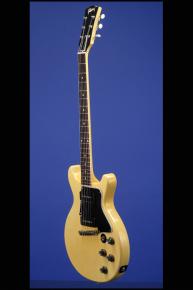One of the Last of the Slab-Bodied "Les Paul" TV Specials
This featherweight guitar weighs just 6.90 lbs. and has a nice, fat nut width of 1 11/16 inches and a standard Gibson scale length of 24 3/4 inches. Solid mahogany body, one-piece medium-to-thin profile mahogany neck, and bound rosewood fretboard with 22 jumbo frets and inlaid pearl dot position markers. Headstock with inlaid pearl "Gibson" logo. Closed-back Kluson Deluxe 'single-line' strip tuners with white plastic oval buttons. Serial number "0 9989 " inked-on in black on back of headstock. Two hot P-90 pickups with outputs of 7.98k and 8.18k. Five-layer (black/white/black/white/black) plastic pickguard. Four controls (two volume, two tone) plus three-way pickup selector switch surrounded by a thin black plastic ring engraved with "RHYTHM" and "TREBLE." The potentiometers are stamped "134 5950" (Centralab December 1959). Two original 'Bumble-Bee capacitors. Black plastic bell-shaped "Bell" knobs with metal tops. Combination "wrap-over" bar bridge/tailpiece. There are a few miniscule marks on the body of the guitar, none of which are through the surface. This is quite simply the cleanest, totally original 'Double-Cut TV Special' that we have ever seen - and what a sound!!!!. We confidently describe this wonderful guitar as being in 9.25 near mint condition. Housed in its original Gibson brown "alligator" softshell case, which is also near mint.
"The double cutaway Special was listed as a Les Paul for less than a year, and in the price list dated 1st November 1959 the model appeared as the SG Special. All the specifications remained the same save for the removal of Les Paul markings on the headstock and the installation of an enlarged one-piece guard covering the area between the front pickup and the fingerboard. For all practical purposes, this latter feature permits to distinguish three slightly different sub-variants of the double cutaway slab-bodied Special between 1959 and 1961. Despite the change of designation, the Specials built between late 1959 and early 1961 are often called Les Paul guitars. It is certainly true structurally, even though a Les Paul/SG designation (and not SG/Les Paul!) would be more appropriate to signal both the thick-body style and the absence of Les Paul markings on the headstock. The last samples were released in early 1961 with serial numbers either inked-on (e.g. #1-0359 registered on 20th March) or impressed into the headstock (e.g. #1155 registered on 22nd March)" (A.R. Duchossoir, Gibson Electrics -- The Classic Years, pp. 211-212).
"In 1955, Gibson launched the Les Paul TV, essentially a Junior but with a finish that the company referred to variously as 'natural', 'limed oak' and (more often) 'limed mahogany'. Surviving original TV models from the 1950s reveal a number of different colours, with earlier examples tending to a rather turgid beige, while later ones are often distinctly yellow. Today there is much debate about where the model's TV name came from...One such theory says that the TV name was used because the pale colour of the finish was designed to stand out on the era's black-and-white TV screens. This seems unlikely, not least because pro players appearing on television would naturally opt for a high-end model...Others say the guitar followed the look of fashionable contemporary furniture, where the expression 'limed' was used for a particular look. Certainly Gibson promoted the Les Paul TV as being 'the latest in modern appearance'. There's also been a suggestion that 'TV' might be a less than oblique reference to the competing blond-coloured Telecaster made by Fender. But in fact the name was coined to cash in on Les Paul's regular appearances at the time on television on The Les Paul & Mary Ford Show. This was effectively a sponsored daily ad for a toothpaste company, for which the couple signed a $2million three-year contract in 1953. Gibson reasoned that if you'd seen the man on TV, well, now you could buy his TV guitar. Following a reader's enquiry to Guitar Player in the 1970s, a Gibson spokesman confirmed that 'the Les Paul TV model was so named after Les Paul's personal Listerine show was televised in the 1950s'" (Tony Bacon, 50 Years of the Gibson Les Paul, p. 28).
The Gibson shipping records show that a total of 3,208 Les Paul Specials were shipped between 1959 and 1960 but this number includes both the TV and the regular Cherry finish. The actual number of TV models would have been relatively small.
Translate:











